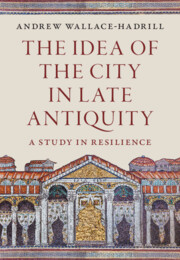Book contents
- The Idea of the City in Late Antiquity
- Praise for The Idea of the City in Late Antiquity
- The Idea of the City in Late Antiquity
- Copyright page
- Dedication
- Contents
- Figures
- Preface
- 1 The End of the Ancient City?
- 2 In Praise of the City
- 3 The City in Question
- 4 The City Revived?
- 5 The City Embattled
- 6 The City and Its Records
- 7 The City of Bishops
- 8 The Grammar of the City
- 9 The Fabric of the City
- 10 Decline and Resilience
- Bibliography
- Index
5 - The City Embattled
Procopius and Justinian’s Urban World
Published online by Cambridge University Press: 30 January 2025
- The Idea of the City in Late Antiquity
- Praise for The Idea of the City in Late Antiquity
- The Idea of the City in Late Antiquity
- Copyright page
- Dedication
- Contents
- Figures
- Preface
- 1 The End of the Ancient City?
- 2 In Praise of the City
- 3 The City in Question
- 4 The City Revived?
- 5 The City Embattled
- 6 The City and Its Records
- 7 The City of Bishops
- 8 The Grammar of the City
- 9 The Fabric of the City
- 10 Decline and Resilience
- Bibliography
- Index
Summary
The perspective of the Greek historian Procopius, narrating the campaigns under Justinian in the East, North Africa, and Italy, proves to coincide with that of Cassiodorus. Procopius’ world is one of cities, with the exception of barbarian zones, which are city free. In Persia, Africa, and Italy was is fought over cities in a series of sieges. Adversaries are judged on their appreciation of critical elements of cities. The Persian Chosroes sacks Roman cities, but builds his own. The Vandals in Africa are sharply criticised for their demolition of city walls, which proves their military undoing. The Goths in Italy have a varied record: Theoderic is given credit for the sort of respect for Roman law, tradition, and city fabric which Cassiodorus documents, but his last successors, especially Totila, earn criticism, and ultimately defeat, for demolishing city walls.
- Type
- Chapter
- Information
- The Idea of the City in Late AntiquityA Study in Resilience, pp. 158 - 195Publisher: Cambridge University PressPrint publication year: 2025

